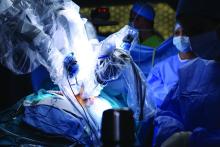Obese people undergoing inguinal hernia repair experienced fewer complications when the surgery was robotic assisted, compared to open repairs, according to Ramachandra Kolachalam, MD, and his associates.
A total of 148 robotic-assisted repairs (RHRs) and 113 open repairs were included in the study. Of open repair (OHR) patients, 11.5% experienced postoperative complications post discharge, compared with only 2.7% of RHR patients. OHR patients also had lower rates of concomitant procedures (16.8% vs. 29.7%) and bilateral repairs (11.5% vs. 35.1%). Morbidity rates did not differ significantly between the groups.
In a smaller analysis in which procedures were matched, 10.8% of OHR patients and 3.2% of RHR patients experienced postoperative complications. Complications in the OHR group included unexpected testicular swelling , urinary retention, deep vein thrombosis, seroma not requiring intervention, hematoma requiring reoperation, wound dehiscence requiring closure, surgical site infection, and skin necrosis. Complications in the RHR group included urinary retention and a seroma not requiring intervention.“Robotic-assisted inguinal hernia repair could lead to increased acceptance of minimally invasive hernia repair with the associated clinical benefits to patients, including those who are obese with higher comorbidities and higher American Surgery Association scores. A prospective study of obesity in RHR is warranted to confirm our findings,” the investigators concluded.
Find the full study in Surgical Endoscopy (2017. doi: 10.1007/s00464-017-5665-z).

